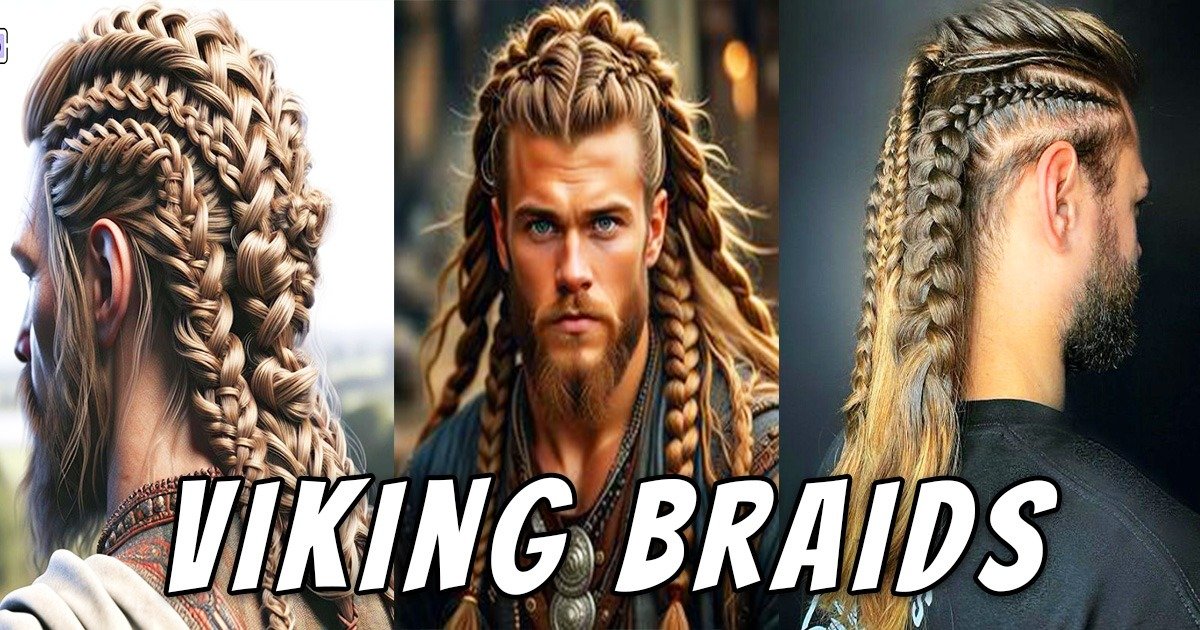What Are Viking Braids? Exploring the History and Meaning
Viking braids are ancient hairstyles that were practical for warriors while also symbolizing strength and power. Vikings, known for their fearlessness, needed hairstyles that kept hair out of their faces while sailing or in battle. These braids were more than functional; they were also a form of self-expression and identity. Viking men and women both wore braids, with the men opting for rough, warrior-like styles and the women often showcasing more intricate designs. The braids were often adorned with beads, leather straps, or metal accessories to personalize the look. Braiding wasn’t just about aesthetics; it was deeply rooted in their culture, representing readiness for battle and a warrior spirit. Today, Viking braids have found their way into modern culture, often seen in TV shows, movies, and on social media. They’re iconic for their rugged, natural appearance that resonates with strength and individuality. Whether worn for a fashion statement or a special event, Viking braids continue to be a symbol of boldness and resilience. The combination of historical significance and modern trends has kept Viking braids relevant in contemporary hairstyling.
What Are Viking Braids Called?
Viking braids didn’t have a specific name in ancient times, but in modern culture, they’re commonly referred to as “Viking warrior braids” or simply “Viking braids.” These names reflect the strong, warrior-like appearance associated with Vikings. Traditionally, Viking men and women both wore different types of braids, but the warriors’ braids stood out due to their rugged and fierce look. They often combined tight braids with shaved sides, giving the style a raw and powerful feel. In today’s culture, Viking braids are a popular choice for people looking to embrace a bold, fearless style. The term “Viking warrior braids” is now widely used to describe any style that mimics the Viking-era look, especially those with added beads, leather wraps, or metal rings. These braids are often used in cosplay, medieval reenactments, and fantasy shows, where the focus is on creating a fierce, warrior-like persona. The appeal of Viking braids lies in their versatility—they can be adapted to various hair lengths and textures, making them accessible to anyone seeking a powerful, statement-making look.
The Most Popular Viking Braid Styles for Men and Women
Viking braids offer a wide variety of styles for both men and women. Viking braids for men often feature a single thick braid running down the back of the head, paired with shaved sides for a bold, warrior-like appearance. The rough and unpolished nature of these braids mirrors the ruggedness of the Viking warriors. Men with long hair can opt for multiple braids, combining them into one larger braid or leaving them separate for a more intricate look. Women, on the other hand, often wear more elaborate Viking braids. Viking braids for women can range from simple single braids to complex, multi-braid styles that create a crown or halo effect. Women’s Viking braids are often adorned with beads, metal rings, or leather wraps to add an authentic feel. Both men and women can incorporate accessories to elevate their Viking braids, making them stand out even more. Whether styled for a casual day or an event, Viking braids offer a look that’s both fierce and stylish. The key to Viking braids is the texture, boldness, and accessories that make them truly iconic.
Are Braids Nordic or African?
Braiding hair is an ancient practice that spans many cultures, but the question often arises: Are braids Nordic or African? The answer is that braiding is not exclusive to either culture. Braids in African culture date back thousands of years, and the intricate styles carried deep cultural significance, representing social status, age, and community identity. In Nordic cultures, braids also played a significant role, particularly during the Viking Age. Viking braids were practical for warriors and sailors, as they kept the hair out of the face during battle or when navigating the seas. While the Vikings popularized certain types of braids in Nordic regions, braiding itself has ancient origins that can be found across the globe. African braids tend to be more intricate and detailed, often requiring more time and skill to complete, while Nordic braids typically favored simplicity and function. Despite these cultural differences, the common thread is that braids are a universal form of hairstyling that has evolved independently in various parts of the world, showcasing the versatility and timelessness of braided hair.
How to Do Viking Braids: A Step-by-Step Tutorial
Creating your own Viking braids at home is easier than you might think. To start, you’ll need to have clean, dry hair, as braiding on wet hair can make the style too tight and uncomfortable. Begin by sectioning your hair into parts, depending on the number of braids you want. For a classic Viking warrior look, part the hair down the middle and create a thick braid down the back of the head. If you want to go for a more complex style, divide your hair into smaller sections and create multiple braids. Once your braids are complete, you can add accessories like beads or leather wraps to enhance the Viking aesthetic. After you finish braiding, use a light hairspray to set the style and keep it in place throughout the day. Viking braids can be adapted for both long and short hair, making them a versatile choice for anyone looking to channel their inner warrior. Whether for an event or daily wear, Viking braids give a bold, timeless look that captures the essence of Viking strength.
Is a Viking Braid a French Braid?
A common misconception is that a Viking braid is the same as a French braid, but the two are quite different. A French braid is a classic style where the hair is braided closely to the scalp, creating a sleek, polished look. The French braid is known for its symmetry and neatness, making it a popular choice for formal occasions. On the other hand, Viking braids are typically rougher, messier, and more complex in appearance. Viking braids often involve multiple smaller braids, combined with loose strands or shaved sides, giving the style a more rugged and unrefined feel. Viking braids can also be adorned with accessories like beads, metal rings, or leather wraps, which add to the bold, warrior-like aesthetic. While the basic braiding technique may be similar, the finished result is completely different. Viking braids focus on creating a wild, primal look that reflects the fierce spirit of the Vikings, whereas French braids are more about neatness and structure. Therefore, while they share a common foundation, Viking and French braids serve very different purposes in hairstyling.
Viking Braids for Long Hair: Bold and Stylish Options
For those with long hair, Viking braids offer endless styling possibilities. One of the most popular looks for long hair is the single thick braid that runs down the back, creating a bold and dramatic effect. This style is inspired by the warrior braids worn by Viking men, who needed a practical way to keep their long hair manageable during battle. To add an authentic Viking touch, many choose to incorporate accessories like beads, metal rings, or leather wraps into the braid. For a more intricate style, long hair can be divided into multiple braids, woven together into a larger braid or left to hang separately. This layered look adds texture and dimension, making it a favorite for those who want a more unique Viking style. Viking braids for long hair are versatile and can be adapted for both casual and formal occasions. Whether you’re heading to a festival, cosplay event, or simply want to change up your daily hairstyle, Viking braids offer a timeless, powerful look that’s sure to turn heads. The key is in the details, from the braid’s texture to the accessories.
Viking Braids for Short Hair: Ideas for a Unique Look
Short hair doesn’t mean you have to miss out on the boldness of Viking braids. There are several creative ways to incorporate braids into short hairstyles, offering a distinct and fierce look. One popular style for short hair is the half-up Viking braid, where the top section of the hair is braided while the rest is left loose or shaved. This creates a contrast between the structured braid and the natural texture of the remaining hair, giving a dynamic Viking-inspired look. Another option is to create tight, small braids along the sides or middle of the scalp, which can be accessorized with beads or rings to add an authentic Viking touch. For a more modern twist, many people with short hair choose to combine braids with an undercut or shaved designs, adding an extra layer of boldness to the style. While short hair may not have the length for more intricate braiding styles, the versatility of Viking braids still allows for plenty of creative options. These braids can be customized to suit individual tastes while still embracing the Viking warrior aesthetic. Plus, they are easy to maintain and can be refreshed quickly, making them ideal for busy lifestyles. The adaptability of these braids ensures that anyone can rock the Viking look, regardless of hair length.

Evelyn White is an experienced content writer with a background in lifestyle, trends, and practical advice. With several years of writing across digital platforms, she specializes in making everyday topics accessible, informative, and engaging. Her goal is to deliver trustworthy, reader-focused content that’s both useful and easy to understand.
Discover more from Try Hard Guides
Subscribe to get the latest posts sent to your email.

